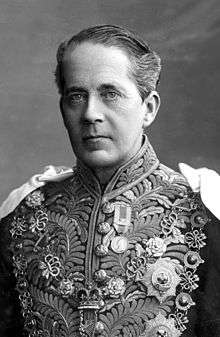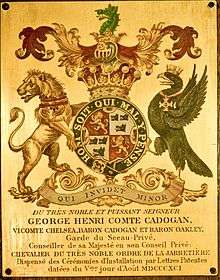George Cadogan, 5th Earl Cadogan
George Henry Cadogan, 5th Earl Cadogan, KG, KP, PC, JP (12 May 1840 – 6 March 1915), styled Viscount Chelsea from 1864 to 1873, was a British Conservative politician.[2][3]
The Earl Cadogan KG KP PC JP | |
|---|---|
 | |
| Lord Lieutenant of Ireland | |
| In office 29 June 1895 – 11 August 1902 | |
| Monarch | Queen Victoria Edward VII |
| Prime Minister | The Marquess of Salisbury Arthur Balfour |
| Preceded by | The Lord Houghton |
| Succeeded by | The Earl of Dudley |
| Personal details | |
| Born | 12 May 1840 Durham, England |
| Died | 6 March 1915 (aged 74) London |
| Nationality | British |
| Political party | Conservative |
| Spouse(s) | (1) Lady Beatrix Craven (1844–1907) (2) Adele Neri (d. 1960) |
| Alma mater | Christ Church, Oxford |

Background and education
Cadogan was the eldest son of Henry Cadogan, 4th Earl Cadogan, by his wife Mary, daughter of Reverend Gerald Wellesley, younger brother of Arthur Wellesley, 1st Duke of Wellington. He was born in the city of Durham and baptised at St James's, Westminster, London. He was educated at Eton College and Christ Church, Oxford. [4]
Military Service
As Viscount Chelsea, Cadogan served as a Major in the 5th (Militia) Battalion of the Royal Fusiliers (City of London Regiment) from 1865 to 1872; he was later Honorary Colonel of the battalion from 1886, and of the 2nd (South) Middlesex Rifle Volunteers from 1892 to 1902.[5]
Political career
In the 1868 general election, he stood unsuccessfully as parliamentary candidate for Bury, Lancashire but was successfully returned as Member of Parliament for Bath in a by-election in May 1873, just before he was ennobled on the death of his father on 8 June and had to move to the House of Lords. He was made Under-Secretary for War in 1875 and Under-Secretary to the Colonies in 1878 by Disraeli.
He served under Lord Salisbury as Lord Privy Seal from 1886 to 1892 (after 1887 in the Cabinet), and again in the cabinet as Lord Lieutenant of Ireland from 1895 to 1902.[6] In the latter office, he supported the Land Act of 1896 which enabled Irish tenants to buy their homes from their landlords' estates and pressed the Treasury for more liberal terms than initially intended, appointed commissions to investigate intermediate education (1899) and university education (1901), and sponsored the Act of 1899 that created a department of agriculture, industries and technical education for Ireland.[7]
He was first Mayor of Chelsea in 1900 and a Justice of the Peace for the counties of Middlesex, Cambridgeshire, Norfolk, Suffolk and London.[5]
Philanthropy
By 1888, at the initiative of the Fifth Earl, building work was well under way at the south-eastern end of London's Sloane Street to rebuild Holy Trinity Church to the design of the leading Arts and Crafts architect John Dando Sedding. Cadogan funded the entire initial operation, including the commissioning of numerous fittings for the new building by leading sculptors and designers including Henry Wilson (who assumed overall artistic control when Sedding died prematurely), Onslow Ford, Edward Burne-Jones, William Morris, Nelson Dawson and Henry Hugh Armstead. Money was found for the installation of a great organ by James John Walker, which quickly became famous for its cathedral-like effect in the opulent acoustic of the building. The church (and its fittings, including the organ) remain a testament to a very particularly focussed example of aristocratic patronage.
As Lord of the Manor of Chelsea he held large estates there, much of which he dedicated to houses for the working class.
During his lifetime Lord Cadogan commissioned a mausoleum for family interments at Brookwood Cemetery but in 1910 he decided he no longer wanted to be interred in the mausoleum. This building, the largest mausoleum in the cemetery, was bought by the cemetery owners, the London Necropolis Company, fitted with shelves and niches to hold urns, and used as a dedicated columbarium from then on.[8]
Family
On 16 May 1865, he married Lady Beatrix Craven, fourth daughter of William Craven, 2nd Earl of Craven. They had nine children:
- Albert Edward George Henry, briefly Viscount Chelsea (1866–1878), a godchild of Albert, Prince of Wales.
- Henry Arthur, Viscount Chelsea (1868–1908)
- Gerald Oakley, 6th Earl Cadogan and briefly Viscount Chelsea (1869–1933)
- Lady Emily Julia (1871–1909), married William Brownlow, 3rd Baron Lurgan.
- Hon. Lewin Edward (1872–1917)
- Lady Sophie Beatrix Mary (1874–1943), married Sir Samuel Scott, 6th Baronet.
- Hon. William George Sydney (1879–1914), killed in action.
- Hon. Edward Cecil George (1880–1962)
- Hon. Alexander George Montagu (1884–1968)
He bought Culford Park, Culford, Suffolk, in 1889 as a family home. It is now a private school.
Lord Cadogan's wife died in 1907 and on 12 January 1911, he married his first cousin once removed, Adele, daughter of Lippo Neri, Count Palagi del Palagio and Olivia Georgiana Cadogan. Lord Cadogan died in Chelsea, London, on 6 March 1915, aged 74. The Countess Cadogan died in February 1960.
References
- Debrett's Peerage, 1968, p.203
- "CADOGAN, 5th Earl (cr. 1800), George Henry Cadogan". Who's Who. Vol. 59. 1907. p. 271.
- "The Correspondence of James McNeill Whistler :: Biography". Whistler.arts.gla.ac.uk. Retrieved 24 June 2019.
- Gibbs, Vicary (editor) (1912). The Complete Peerage, Volume II. St Catherine Press. p. 463.CS1 maint: extra text: authors list (link)States he was born at "Durham College".
- Kelly's Handbook to the Titled, Landed and Official Classes, 1909. Kelly's. p. 308.
- "Home". Parliament Archives. Retrieved 24 June 2019.
- Dictionary of National Biography, Twentieth Century, 1912-1921. Oxford University Press. 1927. pp. 84–85.Article by H.W.C. Davis.
- Clarke, John M. (2004). London's Necropolis; A Guide to Brookwood Cemetery. The History Press. p. 24. ISBN 978-0-7509-3513-5.
External links
| Wikimedia Commons has media related to George Cadogan, 5th Earl Cadogan. |
- Hansard 1803–2005: contributions in Parliament by the Earl Cadogan
| Parliament of the United Kingdom | ||
|---|---|---|
| Preceded by Sir William Tite Donald Dalrymple |
Member of Parliament for Bath 1873 With: Donald Dalrymple |
Succeeded by Donald Dalrymple Viscount Grey de Wilton |
| Political offices | ||
| Preceded by The Earl of Pembroke |
Under-Secretary of State for War 1875–1878 |
Succeeded by Viscount Bury |
| Preceded by James Lowther |
Under-Secretary of State for the Colonies 1878–1880 |
Succeeded by M. E. Grant Duff |
| Preceded by William Ewart Gladstone |
Lord Privy Seal 1886–1892 |
Succeeded by William Ewart Gladstone |
| Preceded by The Lord Houghton |
Lord Lieutenant of Ireland 1895–1902 |
Succeeded by The Earl of Dudley |
| Peerage of Great Britain | ||
| Preceded by Henry Cadogan |
Earl Cadogan 1873–1915 |
Succeeded by Gerald Cadogan |